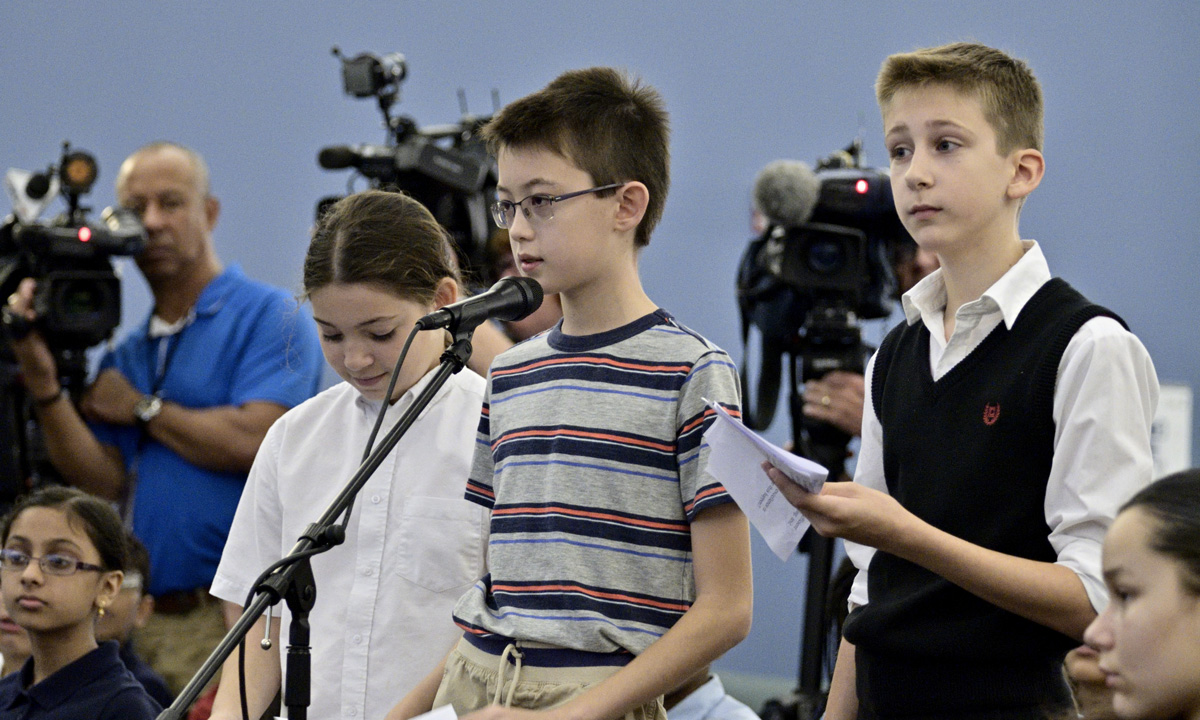Teach Them to Disagree: Why Civility Belongs in Every Classroom
Ryan: Civil discussion must hold as much importance in the school day as math, reading and history. The health of our republic depends on it.

Get stories like this delivered straight to your inbox. Sign up for The 74 Newsletter
Our nation is failing to instill habits of civil disagreement in our young people — habits that are essential to a thriving democracy. According to a recent survey conducted by the Ronald Reagan Presidential Foundation and Institute, young men are alarmingly likely to justify the use of brute force in politics: Only 11 percent of them strongly disagree that brute force can be justified when politics break down. Just 38 percent believe sportsmanship matters after losing an athletic contest. Three quarters believe inviting opposing viewpoints is not a strength, but a sign of surrender.
These findings should serve as a wake-up call for parents and educators across the country.
High schools today rightly emphasize preparing students for college and careers. But if that is all we aim for, we risk graduating young adults who are equipped to earn a living yet ill equipped to live together in a free and pluralistic society. To safeguard our democratic inheritance, students must also learn how to listen closely and disagree well. Civil discussion must hold as much importance in the school day as math, reading and history. The health of our republic depends on it.
Public education in the United States was originally designed to cultivate citizens who could read, reason, vote and make informed decisions. In the 20th century, however, the focus of K-12 education shifted towards practical skills and workforce readiness. The civic mission of schools waned.
Of course, schools must serve multiple purposes. They are charged with job preparation, socialization, character development, emotional resilience and teaching basic life skills, all of which are essential elements of a free and flourishing society. But as civil habits continue to erode in our polarized, outraged public square, a renewed investment in respectful discourse is more urgent than ever.
Today, most government and civics courses tend to prioritize the structural elements of our democracy: branches of government, constitutional texts, founding documents and voting rules. Participating in the democratic process no doubt depends on fluency in these operations. However, these courses too often neglect the skills that allow students to take part meaningfully in public life. They may graduate knowing how government works, yet remain unprepared to listen actively, concede a point or manage disagreement in good faith.
There are practical steps teachers can take to help students become better conversationalists and more thoughtful citizens.
A first step is to promote student autonomy and empowerment by inviting them into the classroom as decision makers. A recent study in the Journal of School Health found that students who are given the chance to make decisions regarding their learning and schoolwork are “more engaged in school, less disruptive in class, and report a stronger sense of belonging and connectedness to their school and peers.
For example, students can be invited to establish ground rules for discussion. These should be created collaboratively with students so they reflect shared ownership and mutual respect. Potential rules might include not interrupting others, using credible evidence to support ideas, and agreeing to revisit the norms regularly. When students help craft the rules, they are more likely to follow them and feel invested in the community they help shape.
This is a foundational principle of democracy. People are far more likely to obey laws and uphold community standards when they themselves had a hand in creating them. They are more willing to pay higher taxes in a participatory government, where they feel they have an influence on the selection of public projects. The same is true in the classroom.
Another crucial step is teaching students how to listen actively. Real dialogue cannot exist without real listening. Educators can model and encourage skills such as paragraphing and asking clarifying questions. One method known as “Say Back” requires students to restate a peer’s point before offering their own response. This approach enforces careful listening and often leads students to temper the intensity of their rebuttals, building empathy in the process.
Teachers might also try an activity called “philosophical chairs” in which students move to different sides of the room based on their views, then switch sides and defend the other position. This physical movement keeps students engaged, while the act of arguing the opposing view builds intellectual humility.
Incorporating open-ended questions into lessons is another powerful strategy that increases student engagement by reducing their fear of failure and judgement. It reframes the objective of the lesson from being “right” to being “thoughtful.” Additionally, students can benefit from being asked not only what they believe, but why someone might see things differently. While this kind of exercise is common in English classes, it is often overlooked in science and math. Yet even in quantitative subjects, students can wrestle with big ideas. They can discuss how scientific knowledge evolves, learning that many once-settled theories were later revised or overturned. This fosters a deeper understanding of uncertainty and change.
Ethical questions also offer rich ground for discussion. Should extinct species be brought back through genetic engineering? What scientific risks are worth taking, whether in medicine, energy or artificial intelligence? These are not just scientific inquiries but moral ones, and students learn not just answers, but critical civility skills when they are asked to weigh competing values with care.
Perhaps most important of all, teachers must model intellectual humility. At the end of the day, students mirror the behavior of their teachers, just as they do with their parents or siblings. A 2024 Developmental Psychology paper found that when teachers exhibit intellectual humility, it boosts students’ motivation and engagement in learning. When teachers admit uncertainty, change their minds, or acknowledge complexity, they send a powerful message that true strength lies not in always being right, but in being willing to learn.
Of course, many teachers already incorporate these strategies in their classrooms. The challenge now is to move beyond scattered examples and toward a cultural shift in which civil discourse becomes a consistent, integrated part of every student’s education.
A growing trust deficit in public education suggests falling confidence from parents. In 1975, 62% of Americans expressed trust in K-12 schools. By 2022, the number had dropped to just 28%. Public schools have found themselves embroiled in the culture war, often accused of partisanship, a perception that has eroded trust.
Restoring trust will not come from dictating what students should think, but from teaching them how to think with clarity and compassion. A renewed emphasis on civil discourse is not about avoiding conflict; it is about learning how to handle it with integrity and care.
Civility is not weakness or passive submission. It is not silence or surrender. It is an active choice to engage, converse, listen, debate, persuade and allow oneself to be challenged. It reflects a deep desire not only to understand our neighbors but to stand up for them when it matters most.
It’s time for K-12 education to embrace this essential work. Our young men, and our democracy, depend on it.
Get stories like these delivered straight to your inbox. Sign up for The 74 Newsletter

;)
